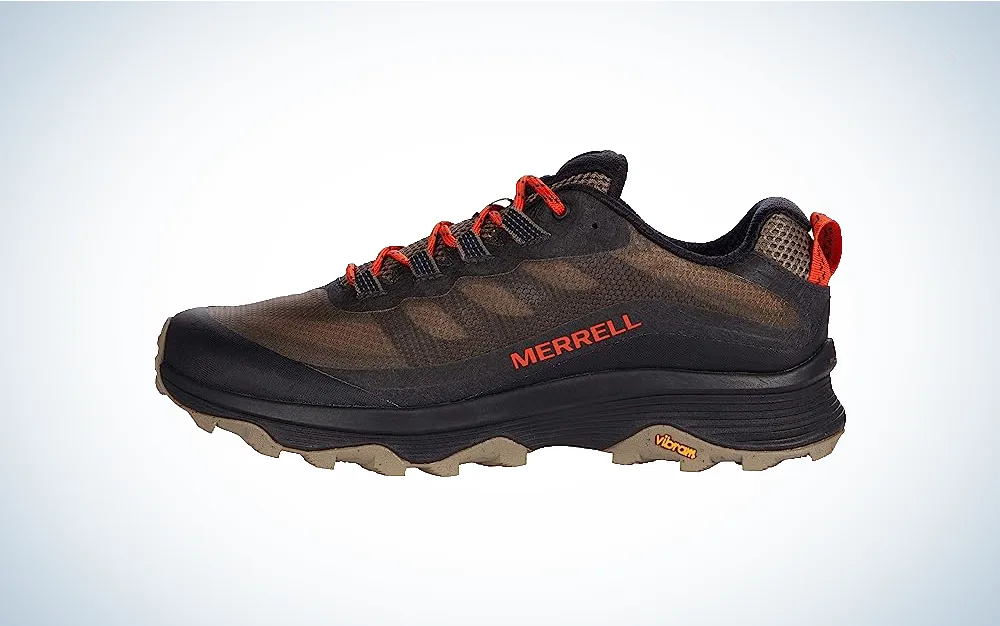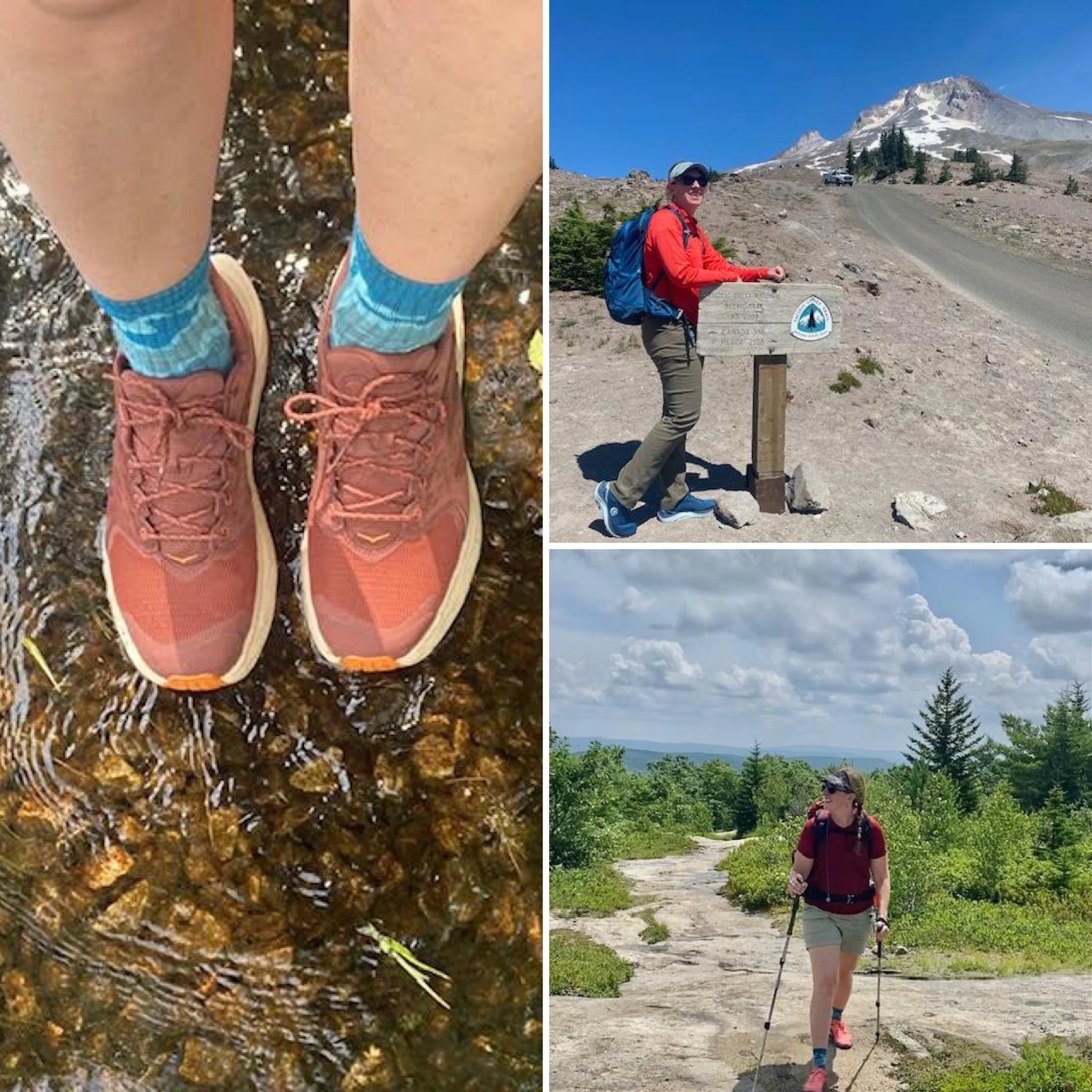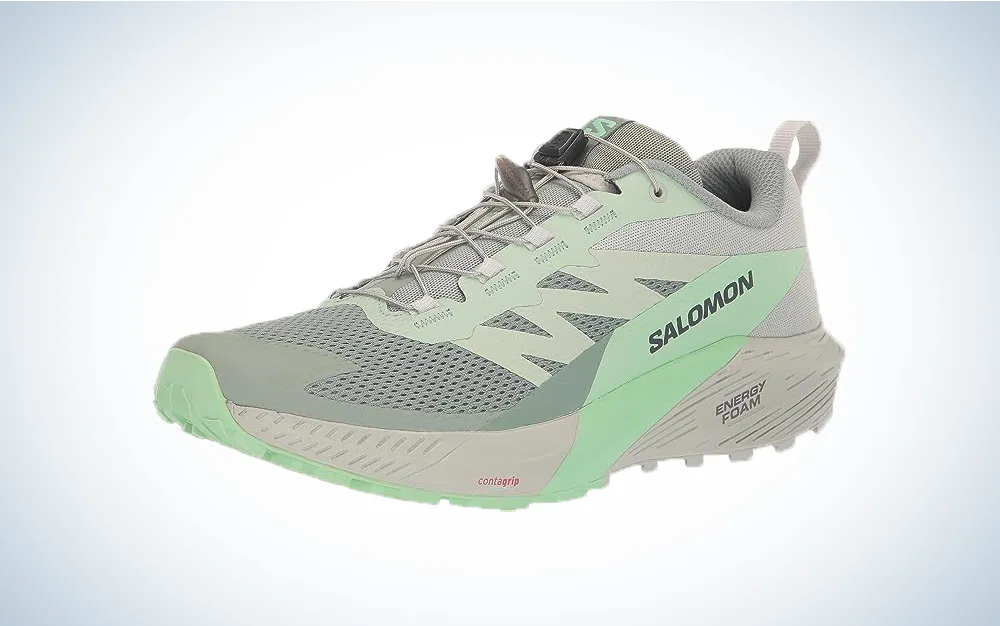_We may earn revenue from the products available on this page and participate in affiliate programs. Learn more ›
_
Best Overall

Topo Terraventure 4
Best Budget

Merrell Moab Speed
Best Zero Drop

Altra Lone Peak 7
Thru hiking shoes are made for backpackers who take long multi-day hikes on extended trails, like the Pacific Crest Trail (PCT) or Appalachian Trail (AT). These hikers carry everything they need on their backs to complete the trail in one trip. That means food, clothes, a sleeping bag, a tent, and the other essentials you need to survive. But one of the most important pieces of gear thru hikers should invest in is a quality pair of hiking shoes.
Long gone are the days when thru hikers wore heavy leather boots. Today, thru hikers lean toward breathable, lightweight, and flexible trail running shoes. These picks are comfortable out of the box, dry quickly, and lead to less fatigue after months on the trail. What’s more, the industry has a wide variety of excellent footwear choices for those ready to tackle a long trail.
This summer, I had the chance to test a wide range of thru hiking shoes that perform well in various conditions. Some excel in certain areas more than others, but they all make long hikes more enjoyable. So before you take on your next big trip, consider the following options to find the best thru hiking shoes for you.
Best Overall: Topo Terraventure 4
Best Budget: Merrell Moab Speed
Best Cushion: Hoka Speedgoat 5
Best Zero Drop: Altra Lone Peak 7
Best High Drop: Salomon Sense Ride 5
Best Waterproof: Hoka Anacapa 2 GTX Low
Best Camp: Xero Shoes Z-Trail EV
How We Picked the Best Thru Hiking Shoes
I used a meticulous methodology to assemble a roundup of the best thru hiking shoes. This process began with interviewing current and past thru-hikers. My detailed discussions about shoe preference, data collection on their shoe choice, and observations about fellow hikers gave me a pulse on what other experts look for in hiking shoes.
Drawing from these insights, I created a list of hiking shoes based on my interviews, brand reputation, and specific features. Lastly, selected shoes were put through an exhaustive testing regimen covering months and endless miles over a variety of trail terrain. Conveniently, my summer travels allowed me to extensively test most of these thru hiking shoes on the Appalachian Trail and the Pacific Crest Trail—both iconic American thru hikes. Each pair of shoes was evaluated on the following criteria:
Fit: While fit can be subjective, the best thru hiking shoes should be snug without causing discomfort or pressure points. I considered factors like toe box width, ankle grip, and overall comfort during different types of movement. All major foot types were considered.
Cushioning and Support: Long days and sometimes nonstop months of hiking require a special type of shoe. While cushioning styles vary on personal preference, it’s important to discuss the cushioning and support offered with each shoe.
Weight: Heavy hiking shoes lead to fatigue. The more breathable and lightweight the shoe, the better.
Brand Reputation and Materials: Brand reputation, as well as quality of materials, manufacturing, and consistency, played a role in top picks.

Best Thru Hiking Shoes: Reviews & Recommendations
Best Overall: Topo Terraventure 4

Specs
Weight: 8.6 oz
Heel-to-toe drop: 3 mm
Traction: Vibram megagrip tread
Optional Features Available: Color, half sizes
Pros
Rock plate protection on forefoot
Wide toe box
Gaiter compatible
Cons
Low stack
The Topo Athletics Terraventure 4 trail running shoe turned out to be an unexpected frontrunner and winner of my test. Despite its status as a smaller brand and its relatively limited presence on the trail thus far, this recent reboot of the Terraventure series was a pleasant surprise. With low stack height and moderate cushioning, this lightweight hiking shoe strikes the ideal balance between agility and comfort. What I liked most about this shoe was the fit—snugly embracing the midfoot and heel for support, yet offering a more relaxed feel with a wide and roomy toe box. In fact, the Terraventure 4 presents a toe box that runs slightly longer, catering to those who opt for thicker socks (like darn toughs) as many thru hikers do.
More smart features include a redesigned upper mesh with incredible breathability, a rock plate to protect a hiker’s foot from sharp objects, and a 6 mm lug with superior traction. While I couldn’t find any fault with them during my one-week test on the PCT in Washington State, it’s worth noting that some thru hikers might prefer a higher stack shoe (like the Hoka Speedgoats or the Topo Ultraventure) which offers greater cushioning for those seeking an extra layer of comfort on their long-distance journeys.
Best Budget: Merrell Moab Speed

Specs
Weight: 11.28 oz
Heel-to-toe drop: 10 mm
Traction: Vibram megagrip tread with 4 mm lugs
Optional Features Available: Wide sizing, half sizes, waterproof/non-waterproof
Pros
Durable
Affordable
Rock Plate and toe cap protection
Cons
Narrow Toe Box
The Merrell Moab Speed Low are traditional hiking shoes that not only pack in value, but also contain a blend of features that many thru hikers are looking for. The rigid, yet breathable fabric delivers a combination of stability and foot protection. While testing, I was able to wedge my foot into rock gaps and scrape against brush without any injury or irritation. Adding to its durability is the incorporated rock plate—a resilient plastic insert between the mid and outsole that protects the foot on the roughest terrains. While durability and protection are unquestionable strengths, these benefits contribute to a slightly heftier weight compared to some competitors on the market.
Toe boxes play a big role in thru hiker comfort, and this model will fit hikers with narrow feet. Given that extended hikes often lead to foot splaying and even growth, I recommend that hikers consider sizing up by at least a half size and possibly exploring the wide range. However, it’s worth noting that while I personally found the narrower toe box less accommodating than rival brands, those with narrower feet who I interviewed raved about Merrell’s preferred fit. Lastly, traction was satisfactory during testing. The low-profile lugs have the possibility to be limited on tricky terrain, but they work well on single tracks and moderate terrain. All in all, the Merrell Moab Speed hiking shoes marry sturdiness, breathability, and protection seamlessly—offering value without compromise.
Best Cushion: Hoka Speedgoat 5

Specs
Weight: 8.50 oz
Heel-to-toe drop: 4.00 mm
Traction: Vibram megagrip tread
Optional features available: Waterproof/non waterproof, high tops, winter spike tread, wide sizing, color, half sizes
Pros
Cushioned and comfortable
Lightweight and breathable
Many personalized options in sizing and features
Cons
Less stability
The Hoka Speedgoats have spent the last few years being a beloved staple within the thru hiking community. Routinely put on lists for best trail hiking shoes
, there are clear reasons why. The newest version—Speedgoat 5—was an impressive standout in my side-by-side shoe testing, particularly outcompeting in the category of comfort and cushioning. With a 33 mm stack height, the Speedgoat offers unparalleled cushioning that serves as a crucial safeguard for joints. While there is no traditional rock plate, the large stack height also provides considerable protection in volume.
Other impressive qualities include exceptional breathability and quick-drying mesh construction. Despite the abundance of cushioning, the Speedgoat 5 remains lightweight, another benefit when every ounce counts. Sizing for the Hoka brand was accurate, and while the toe box wasn’t as wide as the Topo or Altra shoes, it by no means felt narrow. For thru hikers who desire the Hoka cushion with a wider toe box, Hoka sells this shoe in wide sizing as well.
It’s important to acknowledge that the Speedgoat 5’s towering stack height, coupled with its mesh sides, made them a little less stable than other shoes. This was most obvious while navigating steep terrain. However, this did not detract from its overall performance on the majority of trails.
Best Zero Drop: Altra Lone Peak 7

Specs
Weight: 9.2 oz
Heel-to-toe drop: 0 mm
Traction: MaxTrac outsole
Optional features available: Color, half sizes
Pros
Comfortable
Wide toe box
Durable
Cons
Lack of foot protection
You’re looking at the best zero drop thru hiking shoes. It is a favorite amongst thru hikers and an emblem of the natural movement revolution within hiking and running footwear. By maintaining a flat sole, a zero drop design allows users to enhance balance and increase foot strength and responsiveness. The Altra Lone Peak 7 falls in the middle between the zero drop design and moderate cushioning, providing the best of both worlds. The moderate, 25 mm stack height ensures feet remain protected from the rigors of the trail and reduces fatigue on hikes, while the lightweight and resilient mesh is breathable and dries quickly.
This shoe features Altra’s distinctive “original fit”, which boasts an exceptionally wide toe box—ideal for those with wide feet or who prefer to splay their toes. However, I found these shoes deviate from standard sizing and felt too big. I therefore suggest downsizing at least a half size for optimal fit.
As for traction, while the Lone Peak 7s did well on moderate-grade trails and packed dirt, its MaxTrac outsole faltered slightly on wet and tough terrain. In addition, the absence of a traditional rock plate can pose a potential risk against sharp obstacles.
Best High Drop: Salomon Sense Ride 5

Specs
Weight: 8.9 oz
Heel-to-toe drop: 8.3 mm
Traction: Durable 3 and 5mm lug tread
Optional Features Available: Color, half sizes
Pros
Cinch laces
Strong stability
Foot protection
Cons
Less sensitive to trail
Testing confirmed that these shoes are a true-to-size fit that caters to the average foot. They offered a comfortable and secure experience out of the box. With a generous 8.33 mm drop, the Sense Ride 5 is tailor-made for heel strikers—be it hikers or runners—whose stride places the heel first.
The Sense Ride 5 is a little stiffer shoe than some of the others featured. This characteristic provides foot safeguarding and stability which makes it an ideal transition for those accustomed to traditional hiking boots venturing into the realm of trail running shoes. These shoes navigated gravel and mixed trails with well-designed traction. It excels in steep and wet technical terrain, where many other shoes fail. While we were unable to test the product for hundreds of miles, the durable outsole hits at the shoe’s longevity, making it a reliable and high-value companion for thru hikers.
Best Waterproof: Hoka Anacapa 2 GTX Low

Specs
Weight: 12.40 oz
Heel-to-toe drop: 7.00 mm
Traction: Vibram megagrip tread
Optional Features Available: Mid top, high top, low top, Waterproof/non-waterproof, color, half sizes
Pros
Cushioned and comfortable
Waterproof
Stable
Cons
Heavy
While many modern thru hikers lean toward non-waterproof shoes due to rapid drying and breathability, the Hoka Anacapa 2 Low GTX caters to people seeking waterproof functionality without sacrificing stability and breathability. During rigorous testing, this pair of hiking shoes conquered flooded sections of the trail which didn’t result in wet feet. I compared these side by side with the acclaimed Hoka Speedgoat 5, and while both provide excellent comfort and cushioning, the Anacapa was accompanied by a marked increase in foot stability due to the snug heel cups and stiffer nubuck leather sides. The Anacapa also features the SwallowTail heel with a rocker design. This feature helps hikers take weight off the ankle, calf, and Achilles tendon, especially during challenging descents and rocky paths.
Traction and tread were solid features of this shoe. During testing, its uphill performance on steep and wet sections of the trail was commendable. While the downhill traction is slightly less, the Anacapa still had a better grip than most of the competitors on the list.
Best Camp: Xero Shoes Z-Trail EV

Specs
Weight: 4.3 oz
Heel-to-toe drop: 0.00 mm
Traction: Chevron lug pattern traction
Optional Features Available: Color
Pros
Ultralight
Quick Dry
Adjustable
Cons
Slick when wet
The Xero Shoes Z-Trail EV sandal has long been one of the best camp shoes
for its lightweight design and comfort. With pack weight at the forefront of every thru hiker’s mind, camp shoes often feel like a luxury they can’t afford. However, after extensive interviews, the Z-Trail emerged as a resounding favorite for those valuing happy feet during well-deserved breaks. The Z-Trail’s thin and feather-light frame was an immediate standout on a recent backpacking trip. Weighing a mere 4 ounces a shoe, it outshone the bulkier alternatives like the Crocs that I typically pack. With quick-drying capabilities and reliable traction, this sandal proved its worth. I personally wore it with socks around the campfire and later sans socks to get water from the river, although it was pretty slippery on water crossings.
Things to Consider Before Buying Thru Hiking Shoes
The best way to determine the right pair of thru hiking shoes is by trial and error. However, unless you have the time (and money) to try dozens of shoes, you need to rely on recommendations to narrow down your choices. Here are some things to keep in mind:
Foot Shape
Do you have a wide or narrow foot? What about a high arch or flat foot? Analyze your foot shape and find shoes that match well. Read reviews and find a shoe catered to that type.
Stepping Pattern/Foot Strike
Analyze your hiking gait and ask, “How does my foot hit the ground on a step?” Hikers who lead with their heels are called “heel strikers”. If this is you, choose a shoe with a high heel-to-toe drop, extra cushioning, and high stack in order to protect joints and minimize pressure. Forefront or toe strikers should search for roomy toe boxes, while midfoot strikers should try a low or mid-drop shoe.
Stability and Support
Before purchasing a new pair of thru hiking shoes, consider the terrain you will be tackling. Not all thru-hikes are the same, and even different sections vary. Most trail running shoes have traction meant for dirt trails, gravel, and fire roads. Steep, technical, and rocky sections might require tougher traction and stiffer-sided shoes in order to protect and support the foot through challenging areas.
Price/Value
The average thru hiker has to replace their shoes every 300-500 miles on the trail. This means that the average Appalachian Trail thru hiker is replacing their shoes five times over every five to seven months. This adds up, and while it would be great to have an unlimited shoe budget, the truth is that we need to get every mile out of them. Before you fall in love with a $200 plus pair of shoes for your hike, consider if it’s a financially sustainable choice for your journey.
FAQs
Q: Can I use a trail running shoe for hiking?
You can absolutely use a trail running shoe for hiking. In fact, thru hikers usually prefer trail running shoes over hiking boots because they are lighter, offer more agility, are more comfortable, and feature breathable and quick-drying technologies.
Q: What is the difference between a hiking boot and a hiking shoe?
Both are footwear designed for outdoor activities like hiking, trekking, and trail walking, so they serve similar purposes but have the following differences in design, construction, and intended use:
– Support: Hiking boots are typically “high tops” that extend above the ankle. This provides more support and stability. Hiking shoes and trail running shoes are typically low tops that resemble sneakers and offer greater mobility.– Weight: Hiking shoes and trail runners are usually lighter than hiking boots.– Breathability: Hiking boots, especially waterproof boots, lack breathability, which over a long-distance hiking trip could lead to moisture build-up, bacteria, and fungus.
Q: What kind of sole is best for hiking?
The best hiking sole is largely subjective to each hiker’s personal preference, foot shape, and type of use (long-distance hikes vs. short walks). It’s important to try on different hiking shoes and boots in order to find what’s best for your feet. Many thru hikers prefer thicker soles like the Hoka Speedgoats for cushion and comfort, while other hikers prefer a minimalist feel like the Altra Lone Peaks.
Best Thru Hiking Shoes: Final Thoughts
Best Overall: Topo Terraventure 4
Best Budget: Merrell Moab Speed
Best Cushion: Hoka Speedgoat 5
Best Zero Drop: Altra Lone Peak 7
Best High Drop: Salomon Sense Ride 5
Best Waterproof: Hoka Anacapa 2 GTX Low
Best Camp: Xero Shoes Z-Trail EV
A shoe is arguably the most important piece of equipment for a thru hiker. With careful consideration of features, understanding of your terrain needs, and a little trial and error, it’s possible to find the perfect footwear companion for a long journey.
Why Trust Us
For more than 125 years, Field & Stream has been providing readers with honest and authentic coverage of outdoor gear. Our writers and editors eat, sleep, and breathe the outdoors, and that passion comes through in our product reviews. You can count on F&S to keep you up to date on the best new gear. And when we write about a product—whether it’s a bass lure or a backpack—we cover the good and the bad, so you know exactly what to expect before you decide to make a purchase.






